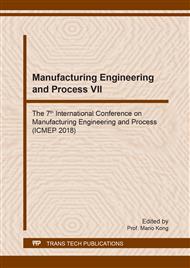[1]
T. M. Eggenhuisen et al., Controlling the Distribution of Supported Nanoparticles by Aqueous Synthesis,, 2013. J. Chem. Mater. 2013, 25, p.890−896.
Google Scholar
[2]
M. A. Basyooni, M. Shaban, and A. M. El Sayed, Enhanced Gas Sensing Properties of Spin-coated Na-doped ZnO Nanostructured Films," Sci. Rep., vol. 7, no. August 2016, p.41716.
DOI: 10.1038/srep41716
Google Scholar
[3]
R. D. Boyd, S. K. Pichaimuthu, and A. Cuenat, Colloids and Surfaces A : Physicochemical and Engineering Aspects New approach to inter-technique comparisons for nanoparticle size measurements ; using atomic force microscopy , nanoparticle tracking analysis and dynamic light scattering,, Colloids Surfaces A Physicochem. Eng. Asp., vol. 387, no. 1–3, p.35.
DOI: 10.1016/j.colsurfa.2011.07.020
Google Scholar
[4]
T. Tran, P. Saveyn, H. Dinh, and P. Van Der Meeren, Determination of heat-induced effects on the particle size distribution of casein micelles by dynamic light scattering and nanoparticle tracking analysis," vol. 18, p.1090.
DOI: 10.1016/j.idairyj.2008.06.006
Google Scholar
[5]
N. J. A. Protocol, Measuring the Size of Nanoparticles in Aqueous Media Using Batch-Mode Dynamic Light Scattering Measuring the Size of Nanoparticles in Aqueous Media Using Batch-Mode Dynamic Light Scattering.,Electronic Publication: Digital Object Identifiers (DOIs).
DOI: 10.6028/nist.sp.1200-6
Google Scholar
[6]
A. Elsaesser et al., Fate and Effects of CeO2 Nanoparticles in Aquatic Ecotoxicity Tests,, p.4537–4546, (2009).
Google Scholar
[7]
S. Rojas et al., In Vivo Biodistribution of Amino-Functionalized Ceria Nanoparticles in Rats Using Positron Emission Tomography,, 2012. Mol. Pharmaceutics, vol. 9, p.3543−355, (2012).
DOI: 10.1021/mp300382n
Google Scholar
[8]
Z. Wen, Y. Zhang, S. Guo, and R. Chen, Journal of Colloid and Interface Science Facile template-free fabrication of iron manganese bimetal oxides nanospheres with excellent capability for heavy metals removal,, J. Colloid Interface Sci., vol. 486, p.211–218, (2017).
DOI: 10.1016/j.jcis.2016.09.026
Google Scholar
[9]
M. N. Musa, S. R. David, I. N. Zulkipli, A. H. Mahadi, S. Chakravarthi and R. Rajabalaya, Development and Evaluation of Exemestane-loaded Lyotropic Liquid Crystalline Gel Forumlations,, Bioimpacts, 7(4), pp.227-239, (2017).
DOI: 10.15171/bi.2017.27
Google Scholar
[10]
A. Pinna et al., Release of Ceria Nanoparticles Grafted on Hybrid Organic − Inorganic Films for Biomedical Application,, J. Mater. Interfaces, 2012, 4, p.3916 − 3922.
DOI: 10.1021/am300732v
Google Scholar
[11]
Y. C. Chau, C. Lee, H. J. Huang, C. Lin, H.P. Chiang, A. H. Mahadi, N. Y. Voo and C.M. Lim, Plasmonic effects arising from a grooved surface of a gold nanorod., J. Phys. D: Appl. Phys. 50 (2017) 125302.
DOI: 10.1088/1361-6463/aa5f47
Google Scholar
[12]
M. Ornatska, E. Sharpe, D. Andreescu, and S. Andreescu, Paper Bioassay Based on Ceria Nanoparticles as Colorimetric Probes,, Anal. Chem. 2011, 83, p.4273–4280, (2011).
DOI: 10.1021/ac200697y
Google Scholar
[13]
J. J. Gulicovski, I. Bra, and S. K. Milonji, Morphology and the isoelectric point of nanosized aqueous ceria sols,, vol. 148, p.868–873, (2014).
DOI: 10.1016/j.matchemphys.2014.08.063
Google Scholar
[14]
D. Arumugam et al., Induced Aggregation of Steric Stabilizing Anionic-Rich 2 ‑ Amino-3- chloro-5-tri fl uoromethylpyridine on CeO2 QDs : Surface Charge and Electro-Osmotic Flow Analysis,, 2016. J. Phys. Chem. C, 2016, 120, p.26544−26555.
DOI: 10.1021/acs.jpcc.6b09082
Google Scholar
[15]
D. Wang et al., Where does the toxicity of metal oxide nanoparticles come from : The nanoparticles , the ions , or a combination of both ?,, J. Hazard. Mater., vol. 308, p.328–334, (2016).
DOI: 10.1016/j.jhazmat.2016.01.066
Google Scholar
[16]
D. R. Lide and G. Baysinger, Team LRN CRC Handbook of Chemistry and Physics.
Google Scholar
[17]
K. Dawkins, B. W. Rudyk, Z. Xu, and K. Cadien, Applied Surface Science The pH-dependant attachment of ceria nanoparticles to silica using surface analytical techniques,, vol. 345, p.249–255, (2015).
DOI: 10.1016/j.apsusc.2015.03.170
Google Scholar


